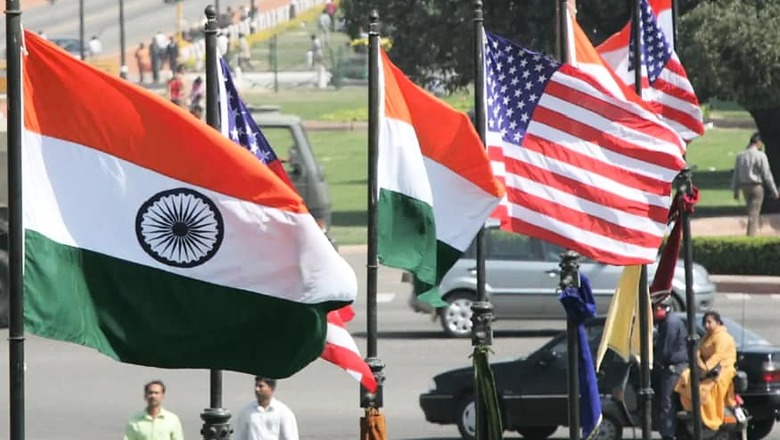
views
India-US ties that were dominated by trade friction in 2018 and 2019 appear to be getting a China-related reset this year. While differences over trade are being ironed out by US Trade Representative Robert Lighthizer and Union Commerce Minister Piyush Goyal, they do not seem to be in prominent focus of the public discourse any more from the American side as it shifts its attention to countering China.
Speaking at the India Ideas Summit on Wednesday, US Secretary of State Mike Pompeo spoke about working “together especially at the time when we see the true scope of the challenges posed by the Chinese Communist Party”. Significantly, he mentioned, “We’ve revived the Quad comprising US, Japan, India and Australia.”
Minutes later, while speaking on how to take the India–US relationship to the next level, US Ambassador to India Kenneth Juster said an important aspect will be how to implement the vision for the Indo-Pacific region, a beginning for which has been made through the engagement in the Quad.
Earlier this week, a US Navy carrier strike group led by USS Nimitz carried out a maritime drill with the Indian Navy in the Indian Ocean. USS Nimitz and USS Ronald Reagan had conducted a major military exercise in the South China Sea just ahead of the drill in the Indian Ocean.
These two events took place just as the US State Department spelled out its position on maritime claims in South China Sea. On July 13, it said, “The United States champions a free and open Indo-Pacific. Today we are strengthening US policy in a vital, contentious part of that region — the South China Sea. We are making clear: Beijing’s claims to offshore resources across most of the South China Sea are completely unlawful, as is its campaign of bullying to control them.”
It has also backed India on the aggressive move of the Chinese People's Liberation Army (PLA) on the Line of Actual Control (LAC).
Pompeo at the India Ideas Summit said the recent clashes initiated by the PLA were just the latest examples of the CCP’s unacceptable behaviour. He added that the US commends the ban of 59 Chinese apps, including TikTok, that pose serious security risk for the Indian people and was happy to note that India is a rising security partner in Indo-Pacific and globally. This reiteration came just a day after he said, “We’ve watched the CCP bully its neighbours, militarise features in the South China Sea, and instigate a deadly confrontation with India.”
It’s only towards the end of his speech did Pompeo make a reference to trade, saying, “India will need to encourage an environment which is open to increased trade and investment.”
Compare this to what had transpired in the previous two years. The US first increased trade tariffs on import of aluminum and steel in 2018. It withdrew India's GSP status in June 2019. The GSP allowed duty-free imports for some products from designated beneficiary countries, including India. The Trump administration accused India of not giving equitable market access to some US products like medical equipment and also piled pressure on doing away with mandatory certification on dairy products, following which GSP was withdrawn.
US President Donald Trump was very vocal about his displeasure on what he believed were unfair trade practices employed by developing countries like India. He used social media to target India over the tariffs and was seen insisting on discussing trade on priority when he met PM Narendra Modi in Osaka, Japan, on the sidelines of the G20 summit and later in Biarritz, France, on the sidelines of the G7 summit in 2019.
Trump had earlier tweeted, “India has long had a field day putting Tariffs on American products. No longer acceptable!"
He had also publicly at a press interaction raised the issue of taxes on Harley Davidson – “So, when Harley sends over there, they have 100 per cent tax. When they (India) send in they make a tremendous number of motorcycles when they send them in, no tax. I called him. I said it's unacceptable.” This referred to his telephone call with Modi.
Meanwhile, as the clouds of trade and tariff continued to overcast ties over the last two years, the India side tried hard to veer the attention away from it to the larger and growing relationship with the US. Sources within the government continued to say that trade was just one aspect of a wider relationship that was well on track.
On Wednesday at the India Ideas Summit, External affairs Minister S Jaishankar said economics in a relationship were “bread and butter issues” but for India and the US, while they work on trade issues, they need to think bigger. In fact, he said that there are two big basket of issues that the two countries should be looking at - one is geopolitical and the second is people-to-people. Each one is a game changer, they reinforce each other and have the potential to create a very durable relationship between India and United States, said Jaishankar.
Clearly for the moment, it appears the focus is on maritime security, counter terrorism, connectivity and maintaining global supply chains – in which India could play a reliable role.




















Comments
0 comment